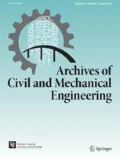Abstract
Civil engineering projects deal with different risks over their life-cycle. Generally, risk sources are categorized into three types of cost, time, and project quality. The Modified Advanced Programmatic Risk Analysis Model (MAPRAM) is one of the leading approaches in this field that can assess the risks of the project on its whole life cycle. Electricity transmission lines have always been one of the most costly and time-consuming infrastructure projects. The costs of these projects play a significant role in a country's development budget. Given the considerable time and cost of constructing the foundations for power transmission towers, providing an economical design will significantly help in reducing duration and budget of these projects. In this study, using MAPRAM, first, different types of foundations of power transmission lines were studied; then the optimal foundations were introduced for a specific place as a case study, shaping a general framework to appoint the optimal foundation for power transmission lines in different areas. The foundations studied in this study included: pad & chimney foundation, auger foundation, steel grillage foundation, concrete piles, and helical piles. Initially, different types of foundations were designed, and then, the costs of each foundation in a whole life-cycle were estimated. Next, the risks and probability of their occurrence were identified for each type of foundation. Finally, the appropriate foundation was determined for the studied soil samples by performing an optimization process.











Similar content being viewed by others
References
Catchpole P (2014) Structural Engineering of Transmission Lines. ICE Publishing
Kalaga S, Yenumula P (2016) Design of electrical transmission lines: structures and foundations. CRC Press
Zeynalian M, Khorasgani MZ. Structural performance of concrete poles used in electric power distribution network. Arch Civ Mech Eng. 2018;18:863–76.
Halpin DW, Lucko G, Senior BA (2017) Construction management. John Wiley & Sons.
Hendrickson C, Au T (2000) Project management for construction: fundamental concepts for owners, Engineers, Architects and Builders, Prentice Hall, Pitsburgh
Kerzner H (2017) Project management: a systems approach to planning, scheduling, and controlling. John Wiley & Sons
Szymański P. Risk management in construction projects. Proc Eng. 2017;208:174–82.
Dziadosz A, Rejment M. Risk analysis in construction project-chosen methods. Proc Eng. 2015;122:258–65.
Thomopoulos NT (2013) Generating continuous random variates, In: Essentials of Monte Carlo Simulation: Springer, pp 27–44.
Allahi F, Cassettari L, Mosca M (2017) Stochastic risk analysis and cost contingency allocation approach for construction projects applying Monte Carlo simulation. In: Proceedings of the World Congress on Engineering, vol. 1.
Baig MMHA, Prasanthi SG (2013) Failure modes and effect analysis of a mechanical assembly by Using Mil-Std 1629a Method," the moon 13(13).
Willmer G Time and cost risk analysis, Computers & Structures 41(6):1149–1155, 1991/01 1991.
Cooper KG (1994) The $2,000 h: How managers influence project performance through the rework cycle, Project Management Institute.
Mulholland B, Christian J. Risk assessment in construction schedules. J Construction Eng Manag. 1999;125(1):8–15.
Mak S, Picken D. Using risk analysis to determine construction project contingencies. J Construction Eng Manag. 2000;126(2):130–6.
Öztaş A, Ökmen Ö. Judgmental risk analysis process development in construction projects. Build Environ. 2005;40(9):1244–54.
Dillon RL, Pate-Cornell ME. APRAM: an advanced programmatic risk analysis method. Int J Technol Policy Manage. 2001;1(1):47–65.
Dillon RL, Paté-Cornell ME, Guikema SD. Programmatic risk analysis for critical engineering systems under tight resource constraints. Oper Res. 2003;51(3):354–70.
Imbeah W, Guikema S. Managing construction projects using the advanced programmatic risk analysis and management model. J Construction Eng Manag. 2009;135(8):772–81.
Zeynalian M, Trigunarsyah B, Ronagh HR. Modification of advanced programmatic risk analysis and management model for the whole project life cycle’s risks. J Construction Eng Manag. 2013;139(1):51–9.
Gamble KB, Lightsey EG. Decision analysis tool for small satellite risk management. J Spacecraft Rockets. 2016;53(3):420–32.
Zeynalian M, Dehaghi IK. Choice of optimum combination of construction machinery using modified advanced programmatic risk analysis and management model. Scientia Iranica. 2018;25(3):1015–24.
Ali AA, Faruq I, Ahmad A, Gandu Y. Exploring the awareness of advanced programmatic risk analysis and management model in managing construction projects in Nigeria. African J Earth Environ Sci. 2020;2(1):465–75.
Bayliss CR, Bayliss C, Hardy B (2012) Transmission and distribution electrical engineering. Elsevier.
Mohajerani A, Bosnjak D, Bromwich D. Analysis and design methods of screw piles: a review. Soils Found. 2016;56(1):115–28.
Perko HA (2009) Helical piles: a practical guide to design and installation. John Wiley & Sons
A. Services, "AMS—Victorian Electricity Transmission Network- Risk Management (PUBLIC VERSION) " in "AMS 10–22 " 2015, Available: https://www.aer.gov.au/system/files/AusNet%20Services%20-%20AMS%2010-22%20-%20Risk%20Management%20-%20Public%20-%20October%202015.pdf.
SCT. (2020). Engineering Services. http://sherantech.com/service.php
ASCE 7-16 Minimum Design Loads and Associated Criteria for Buildings and Other Structures, 2016.
ASTM E917 - 05 - Standard practice for measuring life-cycle costs of buildings and building systems, 2005.
IR2800—Iranian Code of Practice for Seismic Resistant Design of Buildings, 2015.
Dunston PS, Williamson CE. Incorporating maintainability in constructability review process. J Manag Eng. 1999;15(5):56–60.
Griffin J (2003) Life cycle cost analysis: a decision aid, in Life cycle costing for construction: Routledge, pp 147–158.
Paté-Cornell ME. Fault trees vs. event trees in reliability analysis. Risk Anal. 1984;4(3):177–86.
Guikema SD, Paté-Cornell ME. Component choice for managing risk in engineered systems with generalized risk/cost functions. Reliability Eng System Saf. 2002;78(3):227–38.
Wolfram S (1999) The MATHEMATICA® book, version 4. Cambridge university press
Acknowledgements
The authors would like to acknowledge the financial assistance obtained from the Hormozgan Regional Electricity Company (HREC) to conduct this research.
Funding
This study was funded by Hormozgan Regional Electricity Company (HREC) (grant number 44526).
Author information
Authors and Affiliations
Corresponding author
Ethics declarations
Conflict of interest
There is no conflict of interest applicable to this research study.
Ethical approval
This article does not contain any studies with human participants or animals.
Additional information
Publisher's Note
Springer Nature remains neutral with regard to jurisdictional claims in published maps and institutional affiliations.
Rights and permissions
About this article
Cite this article
Mozakka, I., Zeynalian, M. & Hashemi, M. A feasibility study on construction methods of high voltage transmission towers’ foundations. Archiv.Civ.Mech.Eng 21, 41 (2021). https://doi.org/10.1007/s43452-021-00197-4
Received:
Revised:
Accepted:
Published:
DOI: https://doi.org/10.1007/s43452-021-00197-4




